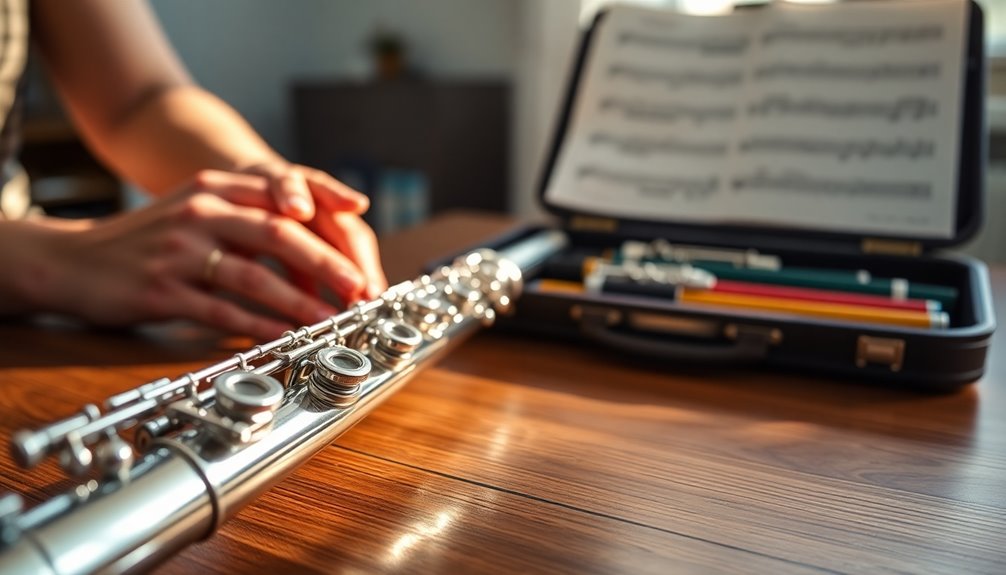As a beginner flutist, start by choosing the right flute to suit your needs, and always care for it properly. Focus on mastering your posture, which helps with sound production. Make a consistent practice routine with specific goals, keeping it varied and engaging. Breath control is vital, so practice deep breathing exercises. Learn basic fingerings and listen to professional flutists for inspiration. Recording your practice sessions is an excellent self-analysis tool. Finally, join a flute community for support and motivation. Embrace the journey, and there's so much more to discover that can enhance your flute playing experience!
Key Takeaways
- Choose the right flute type and material that suits your sound preference and budget for a better playing experience.
- Maintain proper posture while playing to enhance sound production and prevent injuries.
- Set specific goals for each practice session to focus your improvement and track progress.
- Join local flute communities or online groups for support, resources, and motivation from fellow musicians.
- Record your practice sessions to analyze your performance and identify areas for improvement.
Choose the Right Flute

Choosing the right flute is essential for your musical journey, and it can feel overwhelming with so many options available. Don't worry; you're not alone in this! Understanding flute types and brands can help you make a more informed decision.
Start by exploring the different flute types. The most common for beginners is the concert flute, which is typically made of silver or nickel and offers a beautiful, bright sound. You might also consider the piccolo, which is smaller and plays higher notes, or the alto flute, which has a deeper tone. Each type has its unique characteristics, so think about the style of music you want to play.
Next, let's talk about flute brands. Some well-regarded brands include Yamaha, Gemeinhardt, and Pearl. Yamaha flutes are known for their quality and versatility, making them a popular choice among beginners. Gemeinhardt offers flutes that are both affordable and durable, perfect for those just starting out. Pearl flutes provide exceptional craftsmanship and sound quality, making them a great investment as you progress in your playing. Additionally, considering brand reputation can significantly impact your choice, as it ensures long-term usability and access to support services.
As you explore your options, consider trying out different flutes at a local music store. You'll gain valuable hands-on experience and feel more connected to your choice.
Master Proper Posture

Once you've selected the right flute, mastering proper posture is the next step in your journey. Good posture not only enhances your playing but also helps prevent injuries and promotes better sound production.
Start by standing or sitting up straight, ensuring your spine is aligned. Your shoulders should be relaxed and down, avoiding any tension that might creep in.
When holding your flute, position it to the right side of your body, allowing your arms to fall naturally. Maintain a slight bend in your elbows to promote comfort. As you bring the flute to your lips, keep your head level and your neck relaxed—this correct alignment is vital for ideal airflow and technique.
It's essential to remember that relaxation plays a key role in your posture. Tension can hinder your performance, so take a moment to breathe deeply and release any tightness in your body. Imagine a string gently pulling you up from the crown of your head, elongating your body while keeping everything else relaxed.
Practicing the mastery of breath control is crucial for sustaining notes and enhancing your overall sound quality.
Practice this posture regularly, whether you're playing scales or your favorite pieces. You'll find that maintaining correct alignment and body relaxation will make a noticeable difference in your sound quality and endurance.
Develop a Consistent Practice Routine

Establishing a consistent practice routine is essential for any beginner flutist looking to make progress. A well-structured routine not only helps you develop your skills but also builds your confidence as you see tangible results over time.
Start by setting specific, achievable goals for each practice session. Whether it's mastering a scale or learning a new piece, having clear objectives gives your practice purpose and direction.
Time management plays an important role in your routine. Decide how much time you can realistically dedicate to practice each day. It doesn't have to be hours; even 20 to 30 minutes can be effective if focused.
Consistency is key, so try to practice at the same time each day. This creates a habit that will make it easier to stay committed.
To make your practice more enjoyable, mix things up! Incorporate warm-ups, technique exercises, and fun songs to keep your sessions engaging. Additionally, incorporating varied practice routines enhances motivation and engagement, preventing boredom during your sessions.
Consider joining a community of fellow flutists, either online or in-person, to share your progress and learn from each other. This connection can inspire you and keep you motivated.
Finally, don't forget to track your progress. Keeping a practice journal can help you reflect on your achievements, adjust your goals, and celebrate milestones.
Focus on Breath Control

Breath control is a fundamental skill every beginner flutist should prioritize for improved sound and performance. When you master breath support, you'll notice a significant difference in your tone quality and intonation. It's crucial to understand how to use your diaphragm effectively to control your airflow.
Start by practicing deep breathing exercises. Inhale deeply through your nose, allowing your diaphragm to expand rather than just your chest. Feel your abdomen rise as you breathe in. Hold that breath for a moment, then exhale slowly through your mouth, maintaining a steady stream of air. This exercise not only builds your lung capacity but also helps you develop the diaphragm control necessary for playing the flute.
As you play, focus on releasing your breath steadily. Imagine your air as a steady stream, which will help you produce a more consistent and beautiful sound. You can practice this by playing long notes, varying the dynamics and volume. This won't only strengthen your breath support but also improve your musical expression. Additionally, incorporating mindful breathing practices(https://example.com) into your routine can enhance your focus and connection to your music.
Don't be discouraged if you find it challenging at first. Everyone starts somewhere, and with patience and practice, you'll improve. Incorporate breath control exercises into your daily routine, and soon you'll find yourself feeling more confident and connected to your instrument.
Learn Basic Fingerings

Mastering basic fingerings is essential for every beginner flutist, as it lays the groundwork for playing melodies and developing your skills. Start by familiarizing yourself with the basic finger placements for each note. A good way to begin is to create a fingering chart that you can refer to while practicing. This chart will serve as a visual guide, helping you remember which fingers go where.
As you practice, pay close attention to your fingerings. One of the most common fingering mistakes is using the wrong finger for a specific note, which can lead to frustrating sounds and hinder your progress. Make sure to practice slowly and deliberately, ensuring that each finger is placed correctly on the keys. Gradually increase your speed as you become more comfortable.
Another tip is to focus on your hand positioning. Keep your fingers curved and relaxed, hovering just above the keys. This won't only improve your agility but also prevent tension and fatigue during longer practice sessions. Consider investing in a quality flute, such as the Yamaha YFL-222, which is known for its consistent tone and reliability for beginners.
Remember, it's normal to make mistakes when learning; everyone does! If you find yourself struggling, don't hesitate to ask for help from a teacher or a fellow flutist.
Incorporating these basic fingerings into your practice routine will greatly enhance your playing. Be patient with yourself, and celebrate your progress along the way. With time and dedication, you'll find that mastering fingerings is a powerful step toward becoming the flutist you aspire to be.
Use a Metronome

Once you've got the hang of basic fingerings, it's time to refine your timing and rhythm. Using a metronome is one of the best ways to achieve this. A metronome provides a steady beat, helping you develop a sense of timing that's essential for playing with others and tackling more complex pieces.
Start by setting your metronome to a slow tempo—around 60 beats per minute is a good place to begin. Play simple rhythm exercises, focusing on hitting each note precisely with the beat. This will help you internalize the rhythm and improve your overall timing. As you grow more comfortable, gradually increase the tempo.
Try various metronome techniques to keep your practice engaging. For instance, you can practice playing every note on the beat, or you can experiment with playing on the off-beats to challenge yourself.
Another effective approach is to play a scale or a short melody, adjusting the metronome speed as you progress. This not only builds your timing skills but also helps you develop a greater musicality in your playing. Additionally, consider using visual indicators on your metronome, as they can enhance your timing awareness and support consistent practice.
Don't forget to be patient with yourself. Mastering rhythm takes time, and everyone progresses at their own pace. Celebrate your small victories, and remember that using a metronome is a tool that will serve you well on your flute journey. Embrace it, and you'll find yourself growing more confident and precise with each practice session.
Listen to Professional Flutists

Listening to professional flutists can greatly enhance your understanding of the instrument and inspire your playing. By immersing yourself in their performances, you'll not only learn about technique but also discover unique interpretations that can spark your creativity.
Start by exploring various genres; from classical to jazz, and even pop, each style offers different techniques and nuances that you can incorporate into your own playing.
Use specific listening techniques to maximize your experience. Focus on particular elements like tone, dynamics, and phrasing. Try to identify how professional flutists express emotions through their music. You might even want to mimic certain passages to understand the intricacies involved. Listening actively means paying attention to the details, so don't hesitate to rewind and replay sections that catch your ear.
Additionally, consider attending live performances or watching online concerts. The energy of a live setting can be incredibly motivating and will help you appreciate the community of flutists. Engaging with other flutists, both beginner and professional, can deepen your connection to the instrument and inspire you to grow.
Moreover, listening to Broadway songs for flute can offer a unique perspective on musical interpretation and the emotive storytelling inherent in performance.
Record Your Practice Sessions

To truly enhance your flute playing, recording your practice sessions can be a game changer. By capturing your sound, you gain a valuable tool for practice analysis that can lead to significant sound improvement. When you listen to your recordings, you'll hear things you might miss in the moment—like tone quality, timing, and intonation.
Start by setting up your recording device in a quiet space. It doesn't need to be fancy; even your smartphone will do! As you play, focus on your technique and expression, knowing that you can review your performance later.
After your session, take some time to listen critically. Ask yourself questions: Are there areas that need more attention? Is your sound clean and vibrant? Identifying these aspects will allow you to target specific areas for improvement.
Don't let this process intimidate you; think of it as a chance to grow. Each recording reveals a little more about your playing, helping you track your progress over time. Celebrate the small victories, too! If you notice improvements, however minor, acknowledge them—this will boost your motivation.
Lastly, share your recordings with fellow flutists or a mentor. They can offer feedback that further enhances your practice analysis. Additionally, consider using essential flute practice tools like sound analysis software that can provide deeper insights into your performance. Remember, every flutist started somewhere, and recording your sessions puts you on a path to becoming the musician you aspire to be.
Embrace the journey, and watch your skills flourish!
Join a Flute Community

Finding your place in a flute community can greatly boost your learning experience and motivation. Connecting with others who share your passion can provide you with valuable resources and support. Whether you choose to engage in online forums or join local groups, being part of a community makes a world of difference.
Online forums are fantastic for beginners. You can ask questions, share experiences, and receive tips from more experienced flutists. These platforms often have dedicated sections for beginners, making it easier for you to find advice tailored to your level.
Plus, the flexibility of online interactions allows you to participate at your convenience, fitting into your busy schedule.
Local groups, on the other hand, offer a unique opportunity to interact face-to-face. Joining a local flute ensemble or attending workshops can help you meet fellow flutists in your area.
These gatherings often include jam sessions, masterclasses, and performances, giving you a chance to learn and grow alongside others. You'll also find encouragement and camaraderie that can help you stay motivated.
Don't underestimate the power of community. Building connections with other flutists can lead to lifelong friendships and collaborations. Engaging in a supportive flute community can also enhance your overall learning experience, as you have access to shared knowledge and resources.
You'll find that sharing your journey with others not only enriches your experience but also helps you overcome challenges. So, engage with both online forums and local groups, and start reaping the benefits of a supportive flute community today!
Enjoy the Learning Process

Being part of a flute community not only enhances your skills but also allows you to truly enjoy the learning process.
As you initiate your musical journey, it's important to embrace the joys and challenges that come with it. Remember, every flutist was once a beginner, and the key to growth is to celebrate progress, no matter how small. This mindset will help you cultivate patience and foster a love for playing.
Here are some tips to help you enjoy your learning journey:
- Set Realistic Goals: Break down your practice into achievable targets. Celebrate every milestone you reach!
- Seek Feedback: Share your progress with fellow flutists. Constructive criticism can be uplifting and help you improve.
- Experiment with Styles: Try playing different genres of music. It keeps your practice exciting and helps you discover what resonates with you.
- Join Group Activities: Participate in workshops or group classes. The camaraderie can make learning more enjoyable and less isolating.
- Prioritize Regular Maintenance: Keeping your flute in good condition through regular maintenance can greatly enhance your playing experience.
Frequently Asked Questions
How Do I Clean and Maintain My Flute?
Think of your flute as a delicate garden that needs nurturing. To keep it blooming, use gentle cleaning techniques like a soft cloth to wipe down the exterior after each use.
For the insides, a cleaning rod with a swab can help remove moisture. Regular maintenance tips include checking pads for wear and ensuring the keys move freely.
This care not only enhances sound but also deepens your connection with the instrument.
What Should I Do if My Flute Gets Damaged?
If your flute gets damaged, don't panic!
First, assess the damage and see if it's something you can fix, like a stuck key. For more serious issues, look into flute repairs from a professional.
Check your insurance options, too; some policies cover instrument damage.
Keeping your flute in good shape is part of the journey, so stay proactive and connected with fellow musicians who can share their experiences and recommendations.
How Can I Improve My Hand Coordination While Playing?
"Practice makes perfect" is a saying you can really embrace when improving your hand coordination.
Start with simple finger exercises to build muscle memory and dexterity. Focus on proper hand positioning—keep your wrists relaxed and fingers curved over the keys.
Gradually increase speed as you become more comfortable. Remember, consistency is key.
Celebrate small victories along the way, and soon you'll notice a significant improvement in your coordination and overall playing!
What Are Some Common Mistakes Beginner Flutists Make?
As a beginner flutist, you might encounter some common mistakes that can hinder your progress.
One major issue is embouchure mistakes, which affect your tone production. If you're not positioning your lips correctly, the sound won't resonate well.
Additionally, neglecting to focus on breath support can lead to weak tones.
Remember, it's all part of the learning process! Stay patient, practice regularly, and you'll see improvement in no time.
Keep at it!
How Do I Choose the Right Music to Practice?
Choosing the right music for your practice repertoire is essential. Start by selecting pieces that challenge you but are also enjoyable.
Look for a mix of genres to keep things fresh and exciting. Consider your skill level—don't hesitate to tackle something slightly above your comfort zone.
Ask fellow musicians for recommendations, and explore online resources to discover new favorites.
Conclusion
As you begin your flute journey, think of each note you play as a drop of water in a vast ocean. With time, practice, and dedication, those drops will create waves of beautiful music. Embrace the challenges and celebrate your progress—every practice session is a stepping stone toward mastery. Remember, the joy of learning is like a melody that lingers in your heart. So, keep your flute close and let your passion guide you.






